These NCERT Solutions for Class 6 Science Chapter 13 Fun with Magnets Questions and Answers are prepared by our highly skilled subject experts to help students while preparing for their exams.
Fun with Magnets NCERT Solutions for Class 6 Science Chapter 13
Class 6 Science Chapter 13 Fun with Magnets Textbook Exercise Questions and Answers
Question 1.
Fill in the blanks in the following:
a. Artificial magnets are made in different shapes such as ……………., …………… and …………….
b. The materials which are attracted towards a magnet are called ……………..
c. Paper is not a …………….. material.
d. In olden days, sailors used to find direction by suspending a piece of ……………..
e. A magnet always has …………….. poles.
Answer:
a. bar magnet, horse-shoe magnet and cylindrical magnet
b. magnetic materials
c. magnetic
d. lodestone
e. two
Question 2.
State whether the following statements are true or false:
a. A cylindrical magnet has only one pole.
b. Natural magnets were discovered in Greece.
c. Similar poles of a magnet repel each other.
d. Maximum iron fillings stick in the middle of a bar magnet when it is brought near them.
e. Bar magnets always point towards North-South direction when suspended freely in air.
f. A compass can be used to find East-West direction at any place.
g. Rubber is a magnetic material.
Answer:
a. False
b. True
c. True
d. False
e. True
f. True
Question 3.
It was observed that a pencil sharpener gets attracted by both the poles of a magnet although its body is made of plastic. Name a material that might have been used to make some part of it.
Answer:
The blade of a pencil sharpener is made of iron. Since iron is a magnetic material, hence pencil sharpener is attracted towards a magnet.
Question 4.
Column I shows different positions in which one pole of a magnet is placed near that of the other. Column II indicates the resulting action between them for each situation. Fill in the blanks.
| Column I | Column II |
| N-N | |
| N- …………. | Attraction |
| S-N | |
| ……………. S | Repulsion |
Answer:
| Column I | Column II |
| N-N | Repulsion |
| N-S | Attraction |
| S-N | Attraction |
| S-S | Repulsion |
Question 5.
Write any two properties of a magnet.
Answer:
Two properties of magnet are as follows:
- A magnet always points in north-south direction, if suspended freely.
- A magnet always has two poles.
![]()
Question 6.
Where are poles of a bar magnet located?
Answer:
At the two ends.
Question 7.
A bar magnet has no markings to indicate its poles. How would you find out near which end is its north pole located?
Answer:
For this, we need to take following steps:
- Tie the bar magnet with a string and suspend it with a horizontal support.
- Allow the magnet to come to rest.
- Mark the end which points to the north, as north pole.
- Repeat the above steps two more times to confirm.
Question 8.
You are given an iron strip. How will you make it into a magnet?
Answer:
For this, you need to place the iron strip on a flat surface. Now take a bar magnet and place one of its poles near the edge of the strip of iron. Without lifting it, move it along the length of the iron strip till you reach the other end. Now lift the magnet and bring the pole to the same point of strip from where you began. Repeat this process about 30-40 times. Bring some iron fillings near the strip and observe that the strip attracts the filings. This indicates that the iron strip has become a magnet.
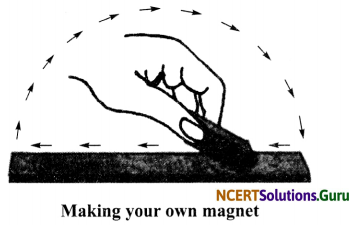
Remember that the pole of magnet and direction of its movement should not be changed.
Question 9.
How is a compass used to find directions?
Answer:
The working of a compass is based on the property of a magnet to stay in north-south direction. This is a small glass case containing a magnetised needle pivoted on a nail. The needle can rotate freely. Whenever it is kept, its needle always rests in north-south direction.
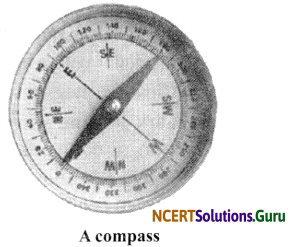
Normally the north pole of the needle is painted red or some other indication is given to identity north and south poles. So using this needle, north and south directions can be identified.
![]()
Question 10.
A magnet was brought from different directions towards a toy boat that has been floating in water in a tub. Effect observed in each case is stated in Column I. Possible reasons for the observed effects are mentioned in Column FI. Match the statements given in Column 1 with those in Column II.
| Column I | Column II |
| 1. Boat gets attracted towards the magnet | (a) Boat is fitted with a magnet with north pole towards its head |
| 2. Boat is not affected by the magnet | (b) Boat is fitted with a magnet with south pole towards its head |
| 3. Boat moves towards the magnet if north pole of the magnet is brought near its head | (c) Boat has a small magnet fixed along its length |
| 4. Boat moves away from the magnet when north pole is brought near its head | (d) Boat is made of magnetic material |
| 5. Boat floats without changing its direction | (e) Boat is made up non-magnetic material |
Answer:
1. (d),
2. (e),
3. (b),
4. (a),
5. (c).
NCERT Extended Learning Activities and Projects
Question 1.
Using a compass, find the direction in which windows and entrance to your house or classroom open.
Hint:
Do it yourself.
Question 2.
Try to place two equal sized bar magnets one above the other such that their north poles are on the same side. Note what happens and write your observations in your notebook.
Hint:
Do it yourself.
Question 3.
Few iron nails and screws got mixed with the wooden shavings while a carpenter was working with them. How can you help him in getting the nails and screws back from the scrap without wasting his time in searching with his hands?
Hint:
We can suspend and rotate a magnet inside the mixture. All the iron nails and screws will get stick to it and separate from the mixture.
![]()
Question 4.
You can make an intelligent doll, which picks up the things it likes (Fig. 13.17 on NCERT). Take a doll and attach a small magnet in one of its hands. Cover this hand with small gloves so that the magnet is not visible. Now, your intelligent doll is ready. Ask your friends to bring different objects near the doll’s hand. Knowing the material of the object you can tell in advance whether the doll would catch it or not.
Hint:
Do it yourself.
Activity 1
Aim: To identify the materials which are attracted by magnet and not attracted by the magnet.
Materials Required: A small bar magnet and waste materials from your house or school.
Procedure:
- Fix a small bar magnet to a wooden stick.
- Move this magnet stick over the dry wastes from different places such as office, home, etc., and record your observations.
Observations:
|
Waste materials |
Materials that get attracted to the magnet |
Materials that do not get attracted to magnet |
| 1. Wastes from school | Pins, blades | Paper, pencil, eraser |
| 2. Wastes from home | Iron scrap, blade | Broken plastic items, empty toothpaste tube, paper scrap, plastic bag |
Conclusion
- Iron, steel, cobalt, nickel and their alloys are magnetic substances which are attracted by a magnet.
- Aluminium, copper, brass, stainless steel, wood, leather and plastic are non-magnetic substances which are not attracted by a magnet.
Poles of a Magnet: A magnet has two poles, viz, North Pole and South Pole. The magnetic power is concentrated on the poles of a magnet. When a bar magnet is suspended to move freely, it always points in the north-south direction. The north pole of the magnet points towards the geographical north and the south pole of the magnet points towards the geographical south.
Activity 2
Aim: To show that a magnet always comes to rest in a fixed direction.
Materials Required: Bar magnet and wooden stand.
Procedure:
- Mark one end of a magnet for identification.
- Hang it from a wooden stand with the help of a thread.
- Allow it to come to rest.
- Mark the direction in which the magnet comes to rest on the ground.
- Now rotate the magnet and observe the direction in which it comes to rest again.
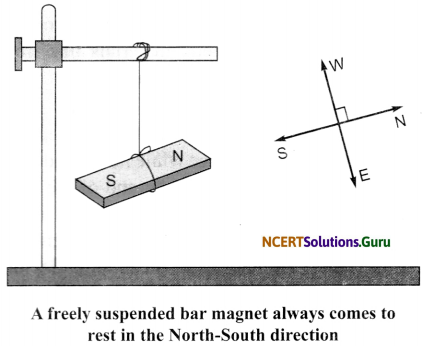
Observations: The magnet always comes to rest in the same direction. The direction is found to be north-south direction.
Conclusion: A freely suspended bar magnet always comes to rest in a particular direction, which is the North-South direction.
Interaction between poles of Magnet
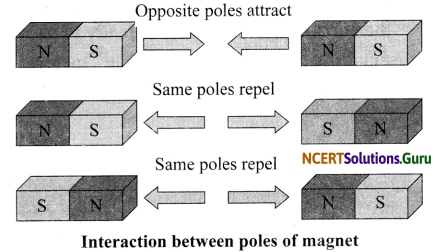
i. Like poles repel each other: This means when north pole of a magnet is brought near the north pole of another magnet, both repel each other. The same holds true for the south poles of two magnets.
ii. Unlike poles attract each other: This means when north pole of a magnet is brought near the south pole of another magnet, both attract each other.
Lodestone: The magnetic stone indicating directions used by sailors in olden days to identify directions is called lodestone.
Strength of a magnet
i. The strength of a magnet is maximum at its poles.
ii. The strength of magnet decreases as we go towards the mid-point of a magnet.
iii. The strength of a magnet is very less or zero at the mid-point of a magnet. It is called neutral point.
![]()
Activity 3
Aim: To show that magnetic force is maximum at the ends of a magnet.
Materials Required: Bar magnets and iron filings.
Procedure:
- Hold a bar magnet and try to stick iron filings across its length and then at its poles.
- Observe the number of iron filings which stick to the magnet as we go from centre towards its poles.
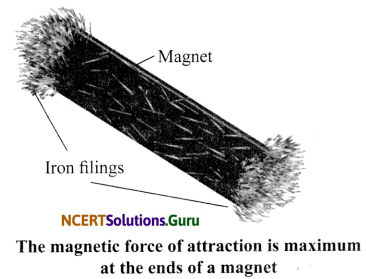
Observations: More number of iron filings stick to the ends of the magnet than at its centre.
Conclusion: The magnetic force is maximum at the ends or poles of the magnet.
- Temporary magnets: They retain their magnetic properties only for a short time. They are usually made up of iron, nickel and cobalt. These materials behave like magnets only when they are brought closer to another strong magnet.
- Permanent magnets: They retain their magnetic properties for a very long period of time. They are usually made up of an alloy containing one or more of the three elements: iron, nickel and cobalt.
- Demagnetisation: The process of destroying the magnetic properties of a magnet is called demagnetisation.
- SeIf-demagnetisation: When two poles of a magnet are left free, the magnet loses its magnetism slowly. This is called self demagnetisation.
- Care of magnets: To avoid self demagnetisation, magnets are kept in such a way that their opposite poles are joined. This is done by placing soft iron pieces (called keepers) across both the ends. A wooden piece may be kept in between the two bar magnets.
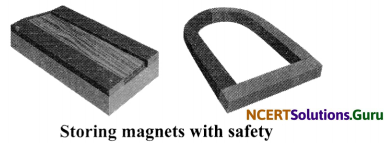
Compass: The small glass case containing a magnetised needle pivoted on a nail in it is called compass. The needle rotates freely and stops in north-south direction. It is used to find directions.
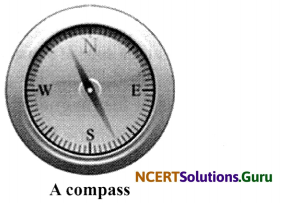
Activity 4
Aim: To make a simple magnetic compass.
Materials Required: A sticker showing all directions, cork and a magnetised needle.
Procedure:
- Pass the magnetised needle through the cork.
- Float it in a trough filled with water, such that the needle is above water.
- Mark the positions (N and S) when it comes to rest.
- Stick the sticker with N and S on it exactly at the place where N and S are marked on the cork. Magnet compass is ready to use.
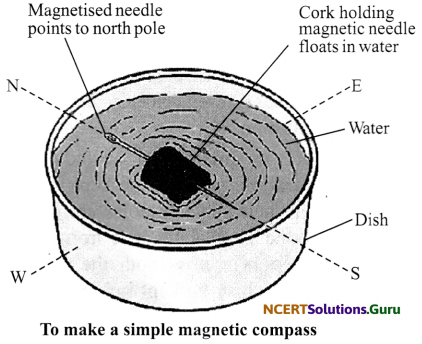
Observations: This is a simple magnetic compass that always points in north-south direction.
Class 6 Science Chapter 13 Fun with Magnets Additional Important Questions and Answers
Very Short Answer Type Questions
Question 1.
What is a magnet?
Answer:
A magnet is an object which attracts things made of iron, steel, nickel and cobalt.
Question 2.
What happens when N-pole of a magnet is brought near the N-pole of a suspended magnet?
Answer:
There is repulsion between these two magnets as there is repulsion between like poles.
Question 3.
At which place on a magnet, its magnetic force is maximum?
Answer:
At poles.
![]()
Question 4.
In which direction does a suspended magnet come to rest?
Answer:
Magnet comes to rest in N-S (north-south) direction.
Question 5.
Name the compound of iron contained in lodestone.
Answer:
The compound of iron is iron oxide or magnetite.
Question 6.
Name the shepherd after which magnet was named.
Answer:
Magnes.
Question 7.
How can you separate a magnetic substance from a mixture?
Answer:
By using a bar magnet, the magnetic substance can be separated from a mixture.
Question 8.
Name a natural material which acts like a magnet.
Answer:
Magnetite.
Question 9.
Can we have an isolated north or South Pole?
Answer:
We cannot have an isolated north pole or south pole. They always exist in pairs.
Question 10.
What are magnetic materials?
Answer:
Materials that get attracted to a magnet are called magnetic materials.
![]()
Question 11.
What are non-magnetic materials?
Answer:
Materials that do not get attracted to magnets are called non-magnetic materials.
Question 12.
Define magnetic poles.
Answer:
The regions of a magnet where the force of magnet is the strongest are called poles of the magnet.
Question 13.
What type of magnet is used in an electric bell?
Answer:
U-shaped magnet is used in electric bell.
Question 14.
Name an instrument which is used to find directions.
Answer:
Magnetic Compass.
Short Answer Type Questions
Question 1.
How can a magnet be demagnetised?
Answer:
A magnet can be demagnetised by heating, hammering or dropping from some height.
Question 2.
How can you tell whether a particular substance is magnetic or non-magnetic?
Answer:
If a particular substance is attracted towards a magnet, then it is a magnetic substance and if it is not attracted towards a magnet, then it is a non-magnetic substance.
![]()
Question 3.
Why should we not keep magnets near mobiles, television, computers and CDs?
Answer:
Devices such as mobiles, television, computers and CDs are made up of magnetic materials and have magnets in them. If we keep magnets near them, magnet may spoil these devices.
Question 4.
Why is a magnet called a ‘magnetic dipole’?
Answer:
Even a smallest piece of a magnet has north and south poles and we cannot separate the two poles. Therefore, poles always exist in pairs. That is why a magnet is called a “magnetic dipole”.
Question 5.
What are electromagnets?
Answer:
Electromagnet is a magnet made by passing electric current through a soft metal surrounded by a coil. The magnetic field disappears when the current is turned off. It is hence, a temporary magnet.
Question 6.
If a bar magnet broke into pieces, then where will its north and south poles occur?
Answer:
Each piece has a north and south pole. Or, we can say, that the end that was pointing south will be the south pole and its opposite end will be the new north pole.
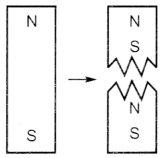
Question 7.
It is said that repulsion is a sure test for magnetism. Why is it so?
Answer:
To identify the magnet, repulsion (like poles of two magnets repel) is the only test which will let you know whether the given material is a magnet or not. This is because both poles of a magnet can attract a magnetic object but only two magnets can repel each other.
![]()
Question 8.
You are given two rods. Out of these, one is an iron rod and the other one is a magnet, how will you identify these rods?
Answer:
Take both the rods and suspend them separately. Bring one end of a bar magnet close to both the ends of the suspended rod. If it shows attraction at both the ends then it is an iron rod. If it shows attraction at one end and repulsion at the other end, then it is a bar magnet.
Question 9.
Write main properties of a magnet.
Answer:
- Magnet has two poles—South Pole and North Pole.
- Poles of a magnet cannot be isolated.
- Like poles repel each other and unlike poles attract each other.
Long Answer Type Questions
Question 1.
Name and describe the instrument that uses a magnet to find direction.
Answer:
The instrument that uses a magnet to find direction is a magnetic compass. This magnet consists of a magnetised needle pivoted at a point so that it can move freely. We have to rotate it till the north of the needle matches the north of the scale.
Question 2.
List any three uses of a magnet.
Answer:
The three uses of magnet are:
- In credit cards and ATM cards where information is stored in a magnetic strip.
- In audio and video tapes and computer hard disks to store information.
- In refrigerator door stickers, closing mechanism of refrigerator doors, bulletin boards and toys.
- Fridge magnets.
Question 3.
Given a bar magnet, how will you find west direction?
Answer:
To find west direction with a bar magnet, we will tie the magnet and leave it freely as a freely suspended magnet aligns itself in north-south direction. As it is free and is tied using a copper wire stirrup, slowly its north pole will itself move towards the geographical north and we can locate the west.
![]()
Question 4.
A bar magnet has no markings to indicate its poles. How would you find out near which end is its north pole located?
Answer:
Take the bar magnet and suspend it freely with the help of a thread. The end that points towards north pole will be regarded as north end of the magnet. Take a bar magnet with known/marked poles on it. Let the north pole of the magnet be brought closer to the suspended magnet at the end that is pointing towards north, if it shows repulsion, then it is confirmed as north pole.
Question 5.
Why does a compass needle get deflected when brought near a bar magnet?
Answer:
The compass needle is a tiny, pivoted magnet which can turn freely in the horizontal plane. The compass needle has a north pole and a south pole just like any other magnet. A compass needle gets deflected when brought near a bar magnet because the bar magnet exerts a magnetic force on the compass needle.
Picture-Based Questions
Question 1.
a. Identify the device shown below.
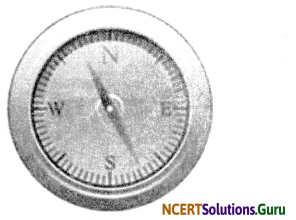
b. In which direction does it point?
Answer:
a. Magnetic compass.
b. North-south direction.
![]()
Question 2.
Observe the given picture and answer the following questions.

a. What is happening in this image?
b. What type of material is used for this purpose.
Answer:
a. An iron strip is being magnetised by rubbing over a magnet.
b. Magnetic materials such as iron, nickel and cobalt are used for this purpose.